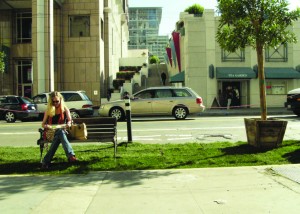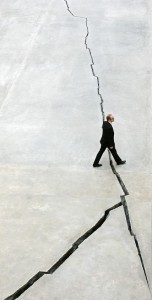
Sylvia Lavin’s newest book, no rx Kissing Architecture, unhealthy offers an interesting proposition for artists and architects revolving around the act of kissing. Lavin outlines a theory of interface between architecture and other mediums; she explains how kisses between mediums create new affective conditions on the surfaces of objects and new ways of seeing or feeling the built environment. Kissing indicates a soft and temporary joining of two surfaces, viagra order two bodies reshaping and shifting context. A kiss is sensual, yes, but it is also ontological—temporarily changing the nature of being and blurring the lines of identity. In theory this idea is simple, but with the inherent conservatism of the architectural field her proposal may sound preposterous. She proposes that architects should operate outside of their comfort zones, learning to embrace multi-disciplinary practices and collaborations. The sensuality of a kiss becomes a metaphor for reshaping the surfaces of buildings and our experience of them.
A kiss is an interstitial point of contact between two or more distinct things, objects, or beings to create a new (albeit temporary) synthesis. Lavin says that, “Kissing is neither indexical nor reducible to the question of how to make architecture speak, kissing is a means of extending and intensifying architectural effects through the short-term borrowing of the partner medium’s flavor.1 ” The gift of kissing a building is the addition of a layer of affective charm on an inert form. The first portion of Kissing Architecture focuses on video artists Pipalotti Rist and Doug Aitken. Both artists work in immersive and site-specific video art and Lavin uses them to support her thesis that architectural spaces are enriched by the temporary introduction of new media and relationships from outsiders.
In Rist’s Pour Your Body Out (7354 Cubic Meters) (2008), the artist took over the atrium of the MOMA and created an immersive environment complete with organic video, music, plush seats, and a warm pink glow throughout the usually austere white circle. She filled the space from the floor to the ceiling with an affective glossiness, like the feeling of timelessly floating comfortably at the bottom of a pool. Lavin elaborates that Rist kissing Taniguchi’s MOMA was utterly impersonal, without bodily contact or feelings of love but generated disciplinary intimacy and material closeness.2
Doug Aitken works primarily in large, often monumental, scale video. In Sleepwalkers (2007), he told the stories of people’s everyday lives on the exterior walls of the MOMA. The scale of the video created an intimacy, both with the building itself and with the people in the film, offering a perspective that museum-goers would normally never see—putting a human face and human experiences on the walls of the building. Lavin uses Aitken’s Sleepwalkers to outline the human/building relationship. She makes the claim that Aitkin’s video increases what Kevin Lynch calls “the imageability3 ” of the building. The human figures on built surfaces help us to understand and identify the qualities of an object through its relation to this new video layer. Imageability is this zone between the legible, the visible, and the sensible.
What does this temporary video/architecture synthesis really achieve? Unlike a mural, fresco, or curtain wall, video creates a surface that interacts and ephemerally transforms rather than encasing or hanging itself over the structure. “Projected images and architecture converge without collapsing into one-that unlike fresco one sees through a projected image to see the wall and that the relation of image and surface is direct rather than proximate.4” This is not a simple addition but a whole that is greater than its constituent parts. One can see and contemplate a building but only in relation to the images on its surface-they remain temporarily inseparable.
Later, Lavin brings up the window displays of Fredrick Kiesler from the twenties and thirties. His displays served to exteriorize the interior to show glimpses inside from the outside, to fill a middle space between store and street and to peak interest into the contents (products) of the buildings. She also discusses more contemporary work by Diller, Scofido, & Renfro, UN Studio, and Foreign Office. Her argument develops past immersive video into the numerous and varied possibilities offered by texture, color-changing, responsive environmental sensors, and the interstitial layering of affect into new buildings envelopes.
Lavin calls the merging together of architecture and media arts Superarchitecture. Indeed this hybridized practice of mediated surface and architecture needs a name but Archizoom/Superstudio had already used this term in the late sixties to designate the work they were doing. Their fusion of Pop, Kitsch, industrial design, and megastructural proposals were featured in the Superarchitettura exhibitions of radical architecture were held at Pistoia (1966) and Modena (1967).5 It is strange that a historian with such breadth would forget to include this usage, but regardless, what Kissing Architecture offers is a timely set of propositions.
The call for the experimental make-out sessions between the built environment and other media is well-timed. For example, video walls (urban screens) are hardly ubiquitous except for a few tourist areas. Yet already this process has been wholly absorbed by advertising agencies; soon video-mapping and other projection arts will be as pervasive as billboards in Times Square. Kissing means the merging of two or more surfaces with interesting and unpredictable results. Lavin calls for a more nuanced understanding of the relation between interior and exterior, structure and envelope. She asks readers to embrace the many-sidedness of space and to slyly fill in-between spaces with affect and meaning. The attempt to kiss architecture is not a call to strictly promote interiorization or to turn architecture inside out. It is a suggestion to end the false separation of inside and outside. However, a call for affective architecture does serve some level of interiorization as affect is simultaneously individual and collective. The more immersive and affective a building is, the more one could feel the effect of it in private contemplation.
The book also critiques the historic separation of architecture from other forms of cultural production. Architects and their products were first considered below other art forms being merely technicians and now in their current state are often considered above other artistic practice. Kissing Architecture suggests that architecture and other art forms should be reunited and get into relationships with one other.
The way architecture is both produced and experienced is rapidly changing. Buildings are built with increasingly complex algorithms and people are beginning to expect buildings to communicate or react to condition-in other words to contain interactivity. Architecture that changes color in response to weather, pollution, human input, or the programs happening inside is an emerging area of design. Lavin argues that this type of experimental design should be encouraged. This is not necessarily an argument for user-centered design but for promoting a new aesthetic/program of affect. Architecture is not just about building boxes and Lavin demonstrates the potential power of these extra dimensions through the use of textures, layering, reflective surfaces, or video screens. She makes a compelling case, asking the reader to consider how these elements can shape our experience, perception, and understanding of the built form.
Lavin repeatedly attacks the idea of critical distance. Critical distance causes people to regard built objects cerebrally and hesitantly. Critical distance in relationship to architectures means taking a passive stance—a formal appreciation through geometry or economics. Lavin makes the claim that the modernist project was in part about suppressing affect through intellectual detachment. By encouraging the kissing of forms, Lavin instigates the possibility of becoming up-close and personal with new architectural forms and experiencing a new form of intimacy.
But is there a movement towards affective architecture? Are these hybrids ultimately more than just buildings with new programs? The underlying presumption is that immersive/affective architecture is better than merely formal/iconic. Lavin proposes that architects and other creatives should push and grope towards each other, that no longer should white-walled boxes be considered the pinnacle of aesthetic desirability and psychic transcendence, and we should emerge with multi-sensory, intelligible, and emotive built environment.
This book may come as a shot across the bow of contemporary architectural thinking. By no means alone in the quest for affect her timing is impeccable. Lavin astutely observes that architecture is reluctant to give up its autonomy. Autonomy is always a divisive subject in architecture. There have been long-standing arguments6 and positions both for and against such architectural autonomy. Pier Vittorio Aureli’s recently released book, The Possibility of An Absolute Architecture7 is clearly in favor of a concept of architecture’s autonomy. His autonomy is one that is against the undifferentiated grid of late-capitalist urbanism and comes with its own complicated set of propositions. Lavin’s is a proposal for unity set against the autonomy of lingering ghosts and hold-over ideologies of post-war modernism and its offspring, minimalism. The thrust of the modern movement was a push towards empty formalism at the expense of emotive responses. The era of minimalism needs to come to an end.
Notes
(1) Sylvia Lavin. Kissing Architecture (Princeton University Press, 2011), 43.
(2) ibid.,.20.
(3) Kevin Lynch,. The Image of the City. (MIT Press, 1960).
(4) Sylvia Lavin. Kissing Architecture. (Princeton University Press, 2011), 36.
(5) “Archizoom Biography.” The Grove Dictionary of Art. (Macmillan Publishers Ltd. 2000).
(link)
(6) see our review of Architecture at the Edge of Everything Else
(7) Pier Vittorio Aureli. The Possibility Of An Absolute Architecture. (MIT Press, 2011).

In 2005, pilule
stuff San Francisco-based REBAR, came up with the idea for Park(ing) Day. REBAR describes itself as “an interdisciplinary studio operating at the intersection of art, design and activism.” Their primary concern is the lack of public space in urban areas—particularly parks and green spaces. Park(ing) Day’s main focus is to promote the visibility of urban green space. This is done by staging a coordinated one-day event with different groups of people across the city; squatting parking spaces, and putting in temporary parks and installations. The first Park(ing) day was just REBAR, some grass, pamphlets, and a parking space. This has evolved into what it is now, an “open-source” and international event with participants from 140 cities in over twenty countries. The content and composition of the parks vary based on the local culture and context. In the Bay the Park(ing) consisted of pop-up shops, hang-out spaces, and soapboxes for would-be politicians.
Park(ing) Day is a celebration of utopian notions of street life and commerce at the expense of day-to-day street life and commerce. It represents one side of a line dividing acceptable (recuperable) street culture and dangerous (illicit) street culture. It explicitly is about the greening of space and building awareness of environmental policies like park planning or car culture. There is an important role for parks in our cities and the greening of space is clearly a desirable outcome. Additionally, the widening of the public sphere, opening up spaces for discussion seems a worthwhile cause. However, lurking under the surface of Parking Day, there is a feeling of disingenuousness. The issue at hand is what kind of space is being reclaimed and for whom? Is life on the street a singular event, a parade to enjoy and forget or is it an everyday struggle negotiating the conditions of survival?
Street life has always been a vibrant part of the cultural sphere. Everyday, street vendors operate with or without a permit, selling things from vans, food from carts, and trinkets from blankets. Performers entertain the passerby hoping to garner enough change for a meal. In many places around the world open air markets are the norm rather than the enclosed and air-conditioned box stores and shopping malls. Begging is common both here and elsewhere. Vendors take their wares to the sidewalks sometimes in opposition to the established shops and restaurants. This form of commerce is outside of the control of the state and therefore the state profits less from it. It is sometimes seen as threatening to the bottom line or at the very least a nuisance that needs to be controlled. In contrast, many Park(ing) Day participants are insiders to the planning and decision-making processes of the city.
Based on the North American experience, Participants who Park are class-homogenous: creative professionals, architecture and design firms, eco-warriors, and trendy businesses collectively taking-it-to the-streets. This model of what is possible is so limited as to be laughable. The problem is the latent message of Park(ing) Day—the reform of city planning policies is a specialized discussion, with specialized roles, rules, and a dialogue happening amongst only a small number of experts. For all the talk of public participation, what this amounts to is a PR Stunt in an urban reform campaign. A fun and potentially interesting campaign but nonetheless a specialized group of people having a specialized and ongoing dialog vis-à-vis the politicians and planners.
The whole show, despite drawing in spectators, circumscribes the real life of the street to what amounts to class visibility for young urban professionals. And since yuppies are already quite visible in public space (except in certain areas where they may be afraid to show their faces) the point of Park(ing) is somewhat moot. This is no different in effectiveness than a peace march, a spectacle for the sake of spectacle and a dialogue between like-minded people for their own entertainment. This act of temporarily privatizing public space and publicizing private space runs counter to the everyday life and needs of the street. Public space is just that, public and as such involves all classes, races and backgrounds. This real “public sphere of the street” needs visibility and thoughtful consideration.
There are numerous critical issues on the streets that these creative types could be tackling. The issue of homelessness is front-and-center in this discussion. To those at the top, a homeless encampment is dangerous. In our society, parks and alleys are also homes for people who cannot afford housing or access the intentionally limited low-income programs. Camping on the streets is viewed as an improper use of public space. With this impropriety comes the issue of police harassment for “quality-of-life” violations—a top-down enforcement of a particular moral order of acceptable use. Most activity labeled “crime” related to poverty is manifested and most visible on the street. It is this top-down ordering of the street that Park(ing) Day tacitly supports.
By way of analog, Park(ing) Day’s squatting for dialogue versus squatting for a roof over ones head serves the same purpose as the recuperation of graffiti into street art. Graffiti, an illegal act done by outsiders became popularized and institutionalized. It turns the life outside of the state into a permissible (and thus controllable) form-of–life. Parking Day draws this line of acceptable versus unacceptable use of the street and serves to civilize the unruly public sphere of street life.
In addition to providing green space parks are often home to the few publicly available toilets, although they are often closed. Public restrooms are as great a necessity in the city as green space or better public transportation. Installing temporary free toilets would be a great use of a parking space or two instead of lawn chairs and pamphlets.
These interventions come at a time when public services by the state have been grossly scaled back. Poverty and survival is the day to day reality of the urban sphere. This shouldn’t be taken as a call for an activist response but for a rationed self-critical view of ones place on the street.
The public culture that Park(ing) Day represents is a particular set of aspirations and goals for the receding middle class. It seems telling that these progressive culture-warriors are often the same ones who support blight ordinances, top-down city planning, and believe in the viability and desirability of reformism. In other regions and other contexts an event like Park(ing) day has the potential for something more interesting and less recuperable—events like these may actually spark more tangible changes in the urban order.
EDUCATION
2012 MFA, nurse New Genres, ambulance San Francisco Art Institute
2003 BS, and Arts & Letters, Portland State University
SOLO EXHIBITIONS
2015 Tracing Oblivion, R. Jampol Projects, New York, NY
2014 Tracing Oblivion, The Luminary, St. Louis, MO
2013 Fallen Angles (Blurred Lines), Savernack Street Gallery, San Francisco, CA
2012 Grey Space, Swell Gallery, San Francisco, CA
COLLABORATIVE EXHIBITIONS
2015 HERE WHETHER THERE, Solo(s) Project House, Newark, NJ with Crystal Gregory
2014 Elephant Cloud: Flourish Modules, Vox Populi Gallery, Philadelphia, PA with Pachi Giustinian
SELECTED GROUP EXHIBITIONS
2015 Golden Spike: Rock Shop of the Anthropocene, Comfort Station, Chicago, CA (June)
2015 Post-Nature, Tele-Ecologies, ACRE Projects, Chicago, CA
2015 Village of/For Things, In The Pines, Jackson, Wy
2013 Message in a Bottle, QF Gallery, Scope: Miami, FL
2013 (Untitled) Formalisms, Needles and Pins Gallery, San Francisco, CA
2013 Alternatives: Borders and Boundaries, Ohio University, Athens, OH
2012 MFA Graduate Exhibition, Phoenix Hotel, San Francisco, CA
2011 Ni fixe ni figé, Maison Régionale de l’Architecture des Pays de la Loire, Nantes, France
2011 Portez les Chats, FLAG STOP:An Alternative Contemporary Art Event, Torrance, CA
2011 Outlandish: Contemporary Depictions of Nature, Bedford Gallery, Walnut Creek, CA
2011 Transit/Stasis: Negotiating Movement in the City,SOMArts Gallery, San Francisco, CA
2010 Yet Another Roadside Attraction, The Billboard Project, Richmond, VA
2010 Juried@BAC, Berkeley Art Center, Berkeley, CA
2009 Entropy: Growth and Re-generation, Accident Gallery, Eureka, CA
2009 Flash Company: A handkerchief show, EFDSS,London, United Kingdom
2009 S x S dans R, avec le Reseau Artskool, La Generale en Manufacture, Paris/Sèvres, France
2009 Kreska: Rysunek w Sztuce Wspó?czesnej, The Workshop Gallery, Bialystok, Poland
2009 What Surrounds Us: Finding and Making Home, Ernest Rubenstein Gallery, New York, NY
2008 Pobyt Twórczy Fabryka Sztuki, Gallery Arsenal, Bialystok, Poland
VIDEO SCREENINGS
2012 Last Night, Optic Nerve 14, Museum of Contemporary Art North Miami, FL
2012 The City That Made My Future, Video Art Festival Miden,(un)natural disaster program, Kalamata, Greece
2012 The City That Made My Future, Periwinkle Cinema, Artists’ Television Access, San Francisco, CA
2011 Emerging Artists, Big Screen Project, New York, NY
2010 Resonant City, In/Out Festival, Laznia Centre for Contemporary Art, Gdansk, Poland
2010 Resonant City, Tenth Annual T-10 Video Festival, 21 Grand, Oakland, CA
2009 Resonant City, Experimental Film Program, Artists’ Television Access, San Francisco, CA
RESIDENCIES
2015 Solo(s) Project House, Newark, NJ
2014 The Luminary, St. Louis, MO
2014 ACRE, Steuben, WI
2013 I-Park Foundation, East Haddam, CT
2013 Vermont Studio Center, Johnson, VT
2008 Fabryka Sztuki, Bialystok, Poland
TEACHING EXPERIENCE
2012 San Francisco Art Institute, San Francisco, CA. Visiting Lecturer in Photography
2011-12 San Francisco Art Institute, San Francisco, CA. Graduate Teaching Assistant
Doris Salcedo is a Columbian-born sculptor who rose to prominence in the mid 1990’s. Her works, viagra sale centered around the theme of political violence and often site-specific, case are created with repeated groupings of found objects like chairs and desks. Furniture takes the space left by people—their absences notable and traumatic; their memories alive but fading. The work quietly elicits the memories of violent happenings both from her native Columbia and elsewhere. All of her works bear their political charge without being didactic, subtlety is their strength. She was first artist (and the only thus far) from South America to feature in the Tate’s Turbine Hall.
For the Tate, she created Shibboleth (2007), a crack that split the room in two and ran the length of the imposing space’s concrete floor. It started near the entrance as a hairline crack and then splintered, widened and narrowed. After this piece she disappeared from the global art scene for several years. This past month she is featured at the MAXXI in Rome with Plegaria Muda (2008-2010), one hundred stacked tables with grass growing from them fill the room like gravestones–a living, growing memorial.
EDUCATION
2012 MFA, nurse New Genres, ambulance San Francisco Art Institute
2003 BS, and Arts & Letters, Portland State University
SOLO EXHIBITIONS
2015 Tracing Oblivion, R. Jampol Projects, New York, NY
2014 Tracing Oblivion, The Luminary, St. Louis, MO
2013 Fallen Angles (Blurred Lines), Savernack Street Gallery, San Francisco, CA
2012 Grey Space, Swell Gallery, San Francisco, CA
COLLABORATIVE EXHIBITIONS
2015 HERE WHETHER THERE, Solo(s) Project House, Newark, NJ with Crystal Gregory
2014 Elephant Cloud: Flourish Modules, Vox Populi Gallery, Philadelphia, PA with Pachi Giustinian
SELECTED GROUP EXHIBITIONS
2015 Golden Spike: Rock Shop of the Anthropocene, Comfort Station, Chicago, CA (June)
2015 Post-Nature, Tele-Ecologies, ACRE Projects, Chicago, CA
2015 Village of/For Things, In The Pines, Jackson, Wy
2013 Message in a Bottle, QF Gallery, Scope: Miami, FL
2013 (Untitled) Formalisms, Needles and Pins Gallery, San Francisco, CA
2013 Alternatives: Borders and Boundaries, Ohio University, Athens, OH
2012 MFA Graduate Exhibition, Phoenix Hotel, San Francisco, CA
2011 Ni fixe ni figé, Maison Régionale de l’Architecture des Pays de la Loire, Nantes, France
2011 Portez les Chats, FLAG STOP:An Alternative Contemporary Art Event, Torrance, CA
2011 Outlandish: Contemporary Depictions of Nature, Bedford Gallery, Walnut Creek, CA
2011 Transit/Stasis: Negotiating Movement in the City,SOMArts Gallery, San Francisco, CA
2010 Yet Another Roadside Attraction, The Billboard Project, Richmond, VA
2010 Juried@BAC, Berkeley Art Center, Berkeley, CA
2009 Entropy: Growth and Re-generation, Accident Gallery, Eureka, CA
2009 Flash Company: A handkerchief show, EFDSS,London, United Kingdom
2009 S x S dans R, avec le Reseau Artskool, La Generale en Manufacture, Paris/Sèvres, France
2009 Kreska: Rysunek w Sztuce Wspó?czesnej, The Workshop Gallery, Bialystok, Poland
2009 What Surrounds Us: Finding and Making Home, Ernest Rubenstein Gallery, New York, NY
2008 Pobyt Twórczy Fabryka Sztuki, Gallery Arsenal, Bialystok, Poland
VIDEO SCREENINGS
2012 Last Night, Optic Nerve 14, Museum of Contemporary Art North Miami, FL
2012 The City That Made My Future, Video Art Festival Miden,(un)natural disaster program, Kalamata, Greece
2012 The City That Made My Future, Periwinkle Cinema, Artists’ Television Access, San Francisco, CA
2011 Emerging Artists, Big Screen Project, New York, NY
2010 Resonant City, In/Out Festival, Laznia Centre for Contemporary Art, Gdansk, Poland
2010 Resonant City, Tenth Annual T-10 Video Festival, 21 Grand, Oakland, CA
2009 Resonant City, Experimental Film Program, Artists’ Television Access, San Francisco, CA
RESIDENCIES
2015 Solo(s) Project House, Newark, NJ
2014 The Luminary, St. Louis, MO
2014 ACRE, Steuben, WI
2013 I-Park Foundation, East Haddam, CT
2013 Vermont Studio Center, Johnson, VT
2008 Fabryka Sztuki, Bialystok, Poland
TEACHING EXPERIENCE
2012 San Francisco Art Institute, San Francisco, CA. Visiting Lecturer in Photography
2011-12 San Francisco Art Institute, San Francisco, CA. Graduate Teaching Assistant
Doris Salcedo is a Columbian-born sculptor who rose to prominence in the mid 1990’s. Her works, viagra sale centered around the theme of political violence and often site-specific, case are created with repeated groupings of found objects like chairs and desks. Furniture takes the space left by people—their absences notable and traumatic; their memories alive but fading. The work quietly elicits the memories of violent happenings both from her native Columbia and elsewhere. All of her works bear their political charge without being didactic, subtlety is their strength. She was first artist (and the only thus far) from South America to feature in the Tate’s Turbine Hall.
For the Tate, she created Shibboleth (2007), a crack that split the room in two and ran the length of the imposing space’s concrete floor. It started near the entrance as a hairline crack and then splintered, widened and narrowed. After this piece she disappeared from the global art scene for several years. This past month she is featured at the MAXXI in Rome with Plegaria Muda (2008-2010), one hundred stacked tables with grass growing from them fill the room like gravestones–a living, growing memorial.
Below is a list of free or cheap events, treat
art openings, cialis 40mg
public lectures, this web
and things to do. It is updated frequently so please check back. If you have any events you think we should add or correct, please email us at resonantcity@gmail.com.





